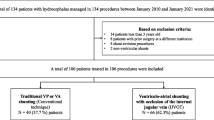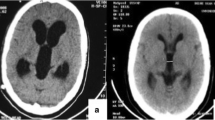Abstract
Ventriculoperitoneal shunting (VPS) is a major therapy for hydrocephalus, but has a significant risk of device malfunctioning. In this study, we explored a novel distal shunt catheter placement method in VPS for the treatment of hydrocephalus. Five patients with different etiologies of hydrocephalus underwent VPS with open distant shunt catheter attached outside. We analyzed different variables (age, gender, medical history, clinical presentation, indication for surgery and surgical technique, postoperative complications) and occurrence of shunt failure and infection. All hydrocephalus patients who received the distal shunt catheter placed outside can undergo regular VPS again after the condition improves. The modified VPS in the treatment of hydrocephalus with the distal shunt catheter placed outside could potentially reduce the necessity of repeat surgery for addressing the complications caused by catheter obstruction and infections, reduce the chance of adhesions, and would be of benefit to those patients who need future revisions.
Similar content being viewed by others
References
Wang, Z. (2008). Neurosurgery (p. 1071). Wuhan: Hubei Science and Technology Press.
Moslem, S., Payman, V., & Iraj, L. (2008). A review of hydrocephalus: History, etiologies, diagnosis, and treatment. Neurosurgery Quarterly, 18(3), 216–220.
Schwamb, R., Dalpiaz, A., Miao, Y., Gonka, J., & Khan, S. A. (2014). Clinical manifestations of hydrocephalus: A review. Neurology and Clinical Neuroscience, 2, 173–177.
Mazzini, L., Campini, R., Angelino, E., et al. (2003). Posttraumatic hydrocephalus: A clinical, neuroradiologic, and neuropsychologic assessment of long-term outcome. Archives of Physical Medicine and Rehabilitation, 84(11), 1637–1641.
Bhatoe, H. S., & Batish, V. K. (2005). Post head injury hydrocephalus. Indian Journal of Neurotrauma, 2(2), 131–133.
Rajshekhar, V. (2009). Management of hydrocephalus in patients with tuberculous meningitis. Neurology India, 57(4), 368–374.
Goel, A. (2002). Tumour induced hydrocephalus and oedema: Pathology or natural defence. Journal of Postgraduate Medicine, 48(2), 153–154.
Yadav, Y. R., Mukerji, G., Shenoy, R., Basoor, A., Jain, G., & Nelson, A. (2007). Endoscopic management of hypertensive intraventricular haemorrhage with obstructive hydrocephalus. BMC Neurology, 7, 1.
Groat, J., & Neumiller, J. J. (2013). Review of the treatment & management of hydrocephalus. US Pharm, 38(3), HS8–HS11.
Yavuz, C., Demirtas, S., Caliskan, A., et al. (2013). Reasons, procedures, and outcomes in ventriculoatrial shunts: a single-center experience. Surg Neurology of International, 4, 10.
Kupeli, E., Yilmaz, C., & Akcay, S. (2010). Pleural effusion following ventriculopleural shunt: Case reports and review of the literature. Annals of Thoracic Medicine, 5(3), 166–170.
Hahn, Y. S., & Raimondi, A. J. (1976). Ventriculo-peritoneal shunting with one piece spring catheter. Technical Note. Yonsei Medical Journal, 17(2), 157–162.
Zhang, Q. (2004). Neurosurgery specifications and typical cases reviews (p. 513). Jinan: Shandong Science and Technology Press.
Chinese Medical Association. (2005). Clinical Practice Guidelines (Neurosurgery Volume) (p. 191). Beijing: People’s Health Publishing Press.
Parker, S. L., Attenello, F. J., Sciubba, D. M., et al. (2009). Comparison of shunt infection incidence in high-risk subgroups receiving antibiotic-impregnated versus standard shunts. Childs Nervous System, 25, 77–83.
Neumiller, J., Neumiller, J., Gates, B., et al. (2007). Normal pressure hydrocephalus. US Pharm, 32(1), 56–61.
Lollis, S. S., Mamourian, A. C., Vaccaro, T. J., & Duhaime, A. C. (2010). Programmable CSF shunt valves: Radiographic identification and interpretation. American Journal of Neuroradiology, 31(7), 1343–1346.
Lee, W. C., Seo, D. H., Choe, I. S., Park, S. C., Ha, Y. S., & Lee, K. C. (2010). A comparative result of ventriculoperitoneal shunt, focusing mainly on gravity-assisted valve and programmable valve. Journal of Korean Neurosurgical Society, 48(3), 251–258.
Kiefer, M., & Eymann, R. (2010). Gravitational shunt complications after a five-year follow-up. Acta Neurochirurgica Supplementum, 106, 107–112.
Pan, S., Guan, M., Wang, Y., et al. (1997). Ventriculoperitoneal shunt complications: Five cases. Chinese Journal of Neurosurgery, 13(6), 341.
Nigim, F., Thomas, A. J., Papavassiliou, E., et al. (2014). Ventriculoperitoneal shunting: Laparoscopically assisted versus conventional open surgical approaches. Asian Journal of Neurosurgery, 9(2), 72–81.
Argo, J. L., Yellumahanthi, D. K., Ballem, N., Harrigan, M. R., Fisher, W. S, 3rd, Wesley, M. M., et al. (2009). Laparoscopic versus open approach for implantation of the peritoneal catheter during ventriculoperitoneal shunt placement. Surgical Endoscopy, 23(7), 1449–1455.
Naftel, R. P., Argo, J. L., Shannon, C. N., Taylor, T. H., Tubbs, R. S., Clements, R. H., & Harrigan, M. R. (2011). Laparoscopic versus open insertion of the peritoneal catheter in ventriculoperitoneal shunt placement: Review of 810 consecutive cases. Journal of Neurosurgery, 115(1), 151–158.
Raysi Dehcordi, S., De Tommasi, C., Ricci, A., Marzi, S., Ruscitti, C., Amicucci, G., & Galzio, R. J. (2011). Laparoscopy-assisted ventriculoperitoneal shunt surgery: Personal experience and review of the literature. Neurosurgical Review, 34(3), 363–370.
Lain, C. H., & Villemure, J. G. (1997). Comparison between ventriculoatrial and ventriculoperitoneal shunting in the adult population. British Journal of Neurosurgery, 11(1), 43–48.
ter Laan, M., & Mooij, J. J. (2006). Improvement after treatment of hydrocephalus in aneurysmal subarachnoid haemorrhage: Implications for grading and prognosis. Acta Neurochirurgica, 148(3), 325–328.
Gu, Z., Xu, A., Sun, Y., et al. (2003). The discussion of the safety and clinical applications in continued lumbar drainage of cerebrospinal fluid. Chinese Neurosurgery, 11(4), 408.
Author information
Authors and Affiliations
Corresponding author
Rights and permissions
About this article
Cite this article
Zhang, Y., Zhu, X., Zhao, J. et al. Ventriculoperitoneal Shunting Surgery with Open Distal Shunt Catheter Placement in the Treatment of Hydrocephalus. Cell Biochem Biophys 73, 533–536 (2015). https://doi.org/10.1007/s12013-015-0697-2
Published:
Issue Date:
DOI: https://doi.org/10.1007/s12013-015-0697-2




